Practical Approaches to Stink Bug Control
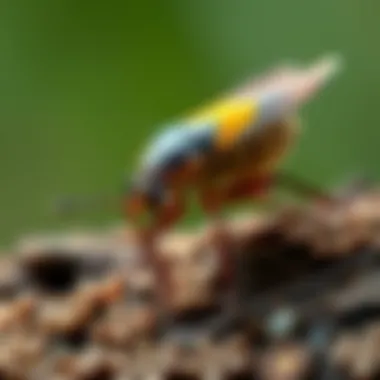
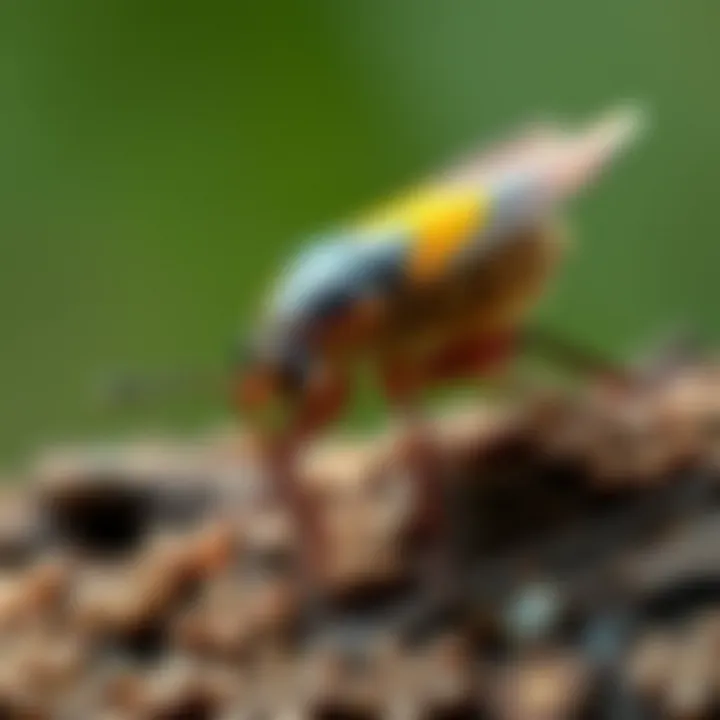
Intro
Dealing with stink bugs can feel like an uphill battle for homeowners and gardeners. Their persistent presence can disrupt the harmony of your home and garden, creating frustration and unease. As these critters are not just an eyesore but can also cause damage to plants, understanding how to effectively manage them is of utmost importance. This guide aims to fill the gaps in your knowledge about stink bug management. We'll discuss identifying these pests, proactive prevention strategies, and even some do-it-yourself solutions you can deploy. Each step you take can play a crucial role in reclaiming your space from these invasive guests.
Pest Identification
Common Household Pests
To tackle any problem, one must first recognize the enemy. Stink bugs, particularly the brown marmorated stink bug, have distinct characteristics. They are often 0.5 to 0.75 inches long and have a shield-like shape. Their color can vary from brown to greenish hues, and a quick glance might even lead one to mistake them for a harmless beetle.
Here’s a quick rundown of some common types:
- Brown Marmorated Stink Bug: Brown with light bands on the antennae.
- Green Stink Bug: More vibrant green with a pungent smell that deters predators.
- Pointed Stink Bug: Has a more elongated form and can be typically found near water sources.
Signs of Infestation
Recognizing the signs of an infestation could save you a lot of headaches down the line. Look out for:
- Visible Bugs: Spotting them on walls or window sills is a clear indicator.
- Unusual Odors: A strong, unpleasant smell when squished is a dead giveaway.
- Damaged Plants: Look for yellowing leaves, wilting, or deformed fruits.
"Identifying the pest is often the first step to peace of mind. Knowing what you're dealing with helps in forming a solid plan to tackle the issue."
Prevention Methods
Environmental Modifications
Preventive measures can go a long way in avoiding a full-blown stink bug invasion. Making your property less conducive to these pests can help keep them at bay.
- Seal Entry Points: Check for cracks and gaps in doors, windows, and even foundations. Caulking can be your best friend.
- Manage Landscaping: Trim back overgrown foliage, especially near entry points. These areas can serve as welcome mats for bugs.
Home Maintenance Tips
Beyond sealing entry points, maintaining cleanliness inside and outside your home is crucial. Regularly cleaning your garden beds and ensuring your trash is securely covered will discourage stink bugs from frequenting your area.
- Keep Vegetation Tidy: Unkempt gardens will attract bugs looking for shelter or food.
- Use Screens on Windows: Ensuring windows and vents have tight-fitting screens can cut down on entry.
DIY Pest Control Solutions
Natural Remedies
If you prefer a gentler approach, perhaps natural remedies could provide you with an effective solution without resorting to chemicals. Common options include:
- Dish Soap and Water: A simple mix can suffocate stink bugs on contact.
- Essential Oils: Scents like peppermint or garlic can repel stink bugs when sprayed around entry points.
DIY Traps and Barriers
Crafting your traps can be a game changer. A basic trap can be made using just a few household items:
- Water and Dish Soap Trap: Fill a bowl with water and add some dish soap. The bugs get trapped when they land on the surface. \
- Light Trap: Set up a light source near a pan of soapy water; stink bugs tend to be attracted to the light and will fall in.
Epilogue
By identifying stink bugs and implementing strategies for prevention and removal, homeowners can create an environment that's less hospitable to these pests. A combination of awareness, environmental modifications, and proactive pest control can turn the tide in this ongoing battle against stink bugs. Proper management doesn’t just restore peace at home but also protects the beauty of your garden and the integrity of your home.
Understanding Stink Bugs
Stink bugs are more than just an occasional nuisance; they can present a significant challenge, especially for homeowners and gardeners. These pests have gained notoriety, particularly in North America, due to their ability to invade homes and wreak havoc on crops and gardens. As awareness about their behavior and patterns grows, it becomes crucial to equip oneself with the knowledge necessary to manage these pests effectively. Understanding stink bugs serves as a foundation for developing practical strategies that can thwart infestations before they escalate.
The importance of grasping the biology and behavior of stink bugs cannot be overstated. For one, it shines a light on their vulnerabilities, making it easier to target or outsmart them. Comprehending what drives their behavior, including their attraction to light and certain plants, helps in anticipation and prevention. This understanding enables homeowners to create environments that are less appealing to these overly aromatic intruders, in turn minimizing the risk of being inundated.
It’s also worth noting that the knowledge of stink bugs’ lifecycles and habitats informs strategic timing for interventions. Timing, after all, is everything; knowing when to expect these bugs can make a world of difference in your approach. Instead of acting reactively—by picking them off windowsills or using a vacuum—one can implement proactive measures that deny stink bugs entry in the first place.
Biology and Behavior
Stink bugs belong to the Pentatomidae family and are often recognized by their distinctive, shield-like shape and the strong odor they emit when threatened. These insects typically exhibit a brown or green coloring, blending in well with their natural surroundings, therefore evading detection. One fascinating aspect of stink bug biology is their method of feeding; they use specialized mouthparts to pierce plant tissues and suck out juices. This feeding behavior can lead to significant damage in crops and ornamental plants alike.
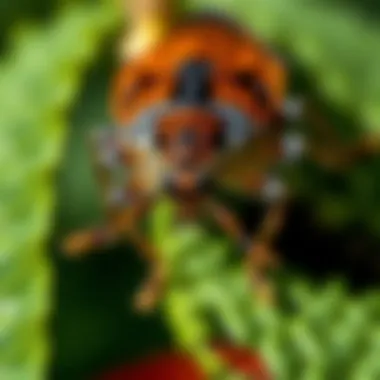
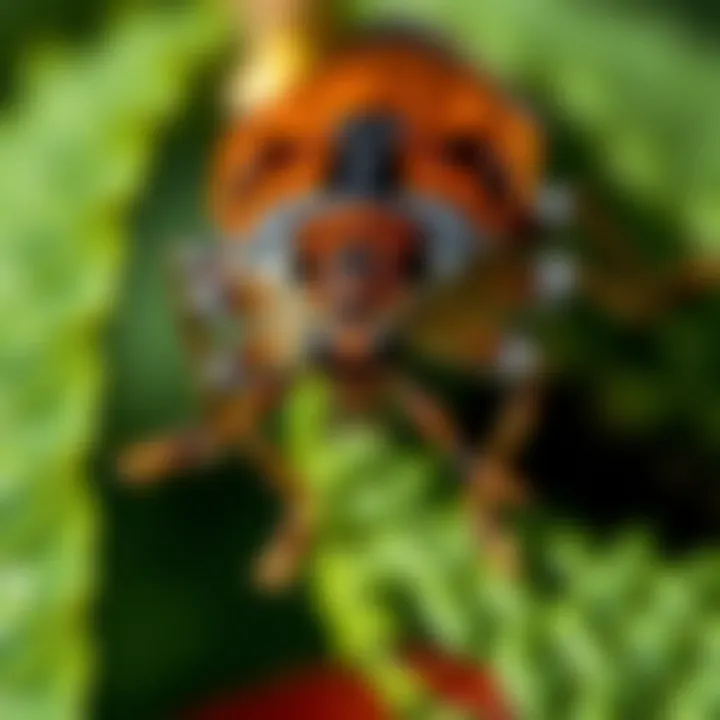
Behaviorally, stink bugs are primarily active during warm months and tend to cluster together as the temperatures begin to drop in the fall. Their social nature leads them to seek shelter in large numbers, making homes a prime target. Noteworthy is their instinct to hibernate in sheltered spots; thus, it's essential for homeowners to seal up entry points well before the cold months set in.
Lifecycle and Habitats
Understanding the lifecycle of stink bugs is fundamental in developing an effective pest management strategy. The average lifecycle consists of four stages: egg, nymph, adult, and in some cases, even winter hiding. Eggs are laid in clusters, often on the underside of leaves, where they hatch into nymphs. Nymphs are smaller and do not have fully developed wings, but they grow progressively larger and eventually become adults.
Stink bugs favor environments that provide both food sources and sheltered areas for overwintering. They are commonly spotted in agricultural fields, gardens, and around residential areas, particularly near plants like tomatoes, peppers, and soybeans. Understanding these habitats can help in both observing and managing stink bug populations.
Common Species in North America
In North America, there are several species of stink bugs, but the most notable are the Brown Marmorated Stink Bug (Halyomorpha halys), the Green Stink Bug (Chinavia hilaris), and the Southern Green Stink Bug (Nezara viridula).
- Brown Marmorated Stink Bug: This species is particularly infamous for its invasive nature and is recognizable by its brown color and characteristic white markings on its abdomen. They are also notorious for entering homes in large numbers during the fall.
- Green Stink Bug: Typically found in gardens, this species can cause significant damage to various plants but is also known to emit a less pungent odor when disturbed.
- Southern Green Stink Bug: Similar in behavior to the Green Stink Bug, this species is often found within agricultural settings, feeding on a variety of crops.
Recognizing these species is essential for effective management. Each type has its specific behaviors and preferences that can provide insights into designing targeted strategies for monitoring and control.
Understanding stink bugs is not just about recognizing them; it's about learning to outsmart them at every turn.
Identifying Stink Bug Infestations
Identifying stink bug infestations is crucial for homeowners and gardeners. They can cause significant damage to plants and produce an unpleasant odor when disturbed. Knowing how to spot their presence can be the difference between a minor inconvenience and major crop loss. Additionally, early detection allows for more effective intervention strategies. With that understanding, recognizing key signs and behavioral indicators of these pests can help you tackle infestations promptly, thereby safeguarding your environment.
Signs of Infestation
Detecting the signs of a stink bug infestation is not as tricky as it might seem. Here are some telltale signs to watch out for:
- Visible Presence: The first indicator is often simply seeing them. Stink bugs are mottled brown or green and have a shield-like shape. Their size can range from half an inch to over an inch long. Their odd shape makes them stand out.
- Damage on Plants: Look for dark spots or yellowing leaves on your plants. These discolorations could signify that stink bugs have been feeding on the sap, leading to weakened plants.
- Droppings: If you see small droppings around the base of your plants or on windowsills, those could be from stink bugs. It’s both unsightly and indicative of a population nearby.
- Egg Clusters: In spring or summer, keep an eye out for clusters of yellow eggs that look like tiny pearls. They’re often found on the underside of leaves and can hatch into new adults within a week.
By paying attention to these signs, you can identify stink bug infestations early and take decisive action before they become too widespread.
Behavioral Indicators
Understanding the behavior of stink bugs can provide additional clues about their presence. Here are some behaviors to note that may indicate an infestation:
- Aggregating Behavior: Stink bugs often gather in groups, especially during seasonal changes. If you spot a collection of these bugs on the exterior of your home or clustering near windows, it’s a good indicator that they are seeking shelter.
- Flight Patterns: If you notice them flying around your living space, they are likely trying to get indoors, particularly when temperatures drop. They tend to enter homes to hibernate during colder months.
- Feeding Activity: When actively feeding, stink bugs use their mouthparts to puncture plant tissues. This creates small puncture wounds that can subsequently lead to brown splotches on the leaves. Observing these feeding sites can reveal their favored plants.
- Movement Patterns: Pay attention to their movement; stink bugs are not very agile. If they frequently pause before moving, that can signal their comfort level with the area. This might lead to them establishing a base for breeding.
By keeping an eye out for these indicators, you can maintain a proactive stance in your stink bug management efforts.
Early identification of stink bugs can significantly mitigate risks to your plants and home, making it essential for anyone in the field of gardening and pest management.
This awareness lets you act swiftly, employing effective pest control strategies to protect your household and garden.
Prevention Techniques
Preventing stink bugs from invading your living spaces is not just a strategy; it's a cornerstone of effective pest management. A proactive approach can save homeowners from the headaches and expense of dealing with a full-blown infestation. The importance of prevention techniques lies in their ability to create barriers and modify environments, making it difficult for these pests to settle in.
By focusing on effective methods from exclusion to habitat modification, individuals can ensure a less hospitable environment for stink bugs while promoting a pest-free home. Let’s break down these strategies further.
Exclusion Methods
Exclusion is simply adding physical barriers to keep stink bugs from making themselves at home. Homes are like open buffet bars for these pests during the fall months when they seek shelter from the cold. To close the buffet, the first step is sealing entry points. Here are some ways to do it:
- Seal cracks and gaps: Use caulk or weather stripping to close any openings around windows and doors. Even the tiniest crack can be an invitation.
- Screen windows and vents: Ensure that all windows and vents have tight, well-fitted screens without holes that little critters can slip through.
- Inspect utility openings: Pay attention to areas where utilities enter your home, like pipes and electrical lines. This is often overlooked but vital.
By implementing these measures, you not only stop stink bugs but might also block other unwelcome visitors. A diligent approach to exclusion can make a world of difference.
Habitat Modification
After addressing exclusion, the focus should shift to habitat modification. The environment around your home can be a magnet for stink bugs if not carefully managed. Here are some key details:
- Clear debris: Regularly clean away leaf litter, tall grasses, and other organic debris close to your home's foundation. These areas can provide shelter for stink bugs.
- Trim vegetation: Keep landscaping neat and avoid having shrubs or trees too close to the house, as they can serve as bridges.
- Manage outdoor lighting: Bright lights can attract stink bugs. Opt for yellow “bug lights” which are less likely to draw them in.
A few small adjustments in your garden can significantly deter these bugs. Think of it like cleaning your house; a well-maintained environment is less appealing to pests.
Using Deterrent Plants
Some plants can act as nature’s bouncers against stink bugs. Strategic planting can deter these pests from settling near your home. Here are a few plants you might consider:
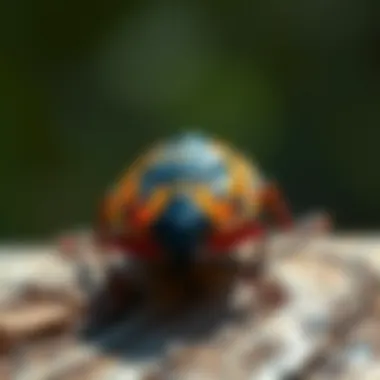
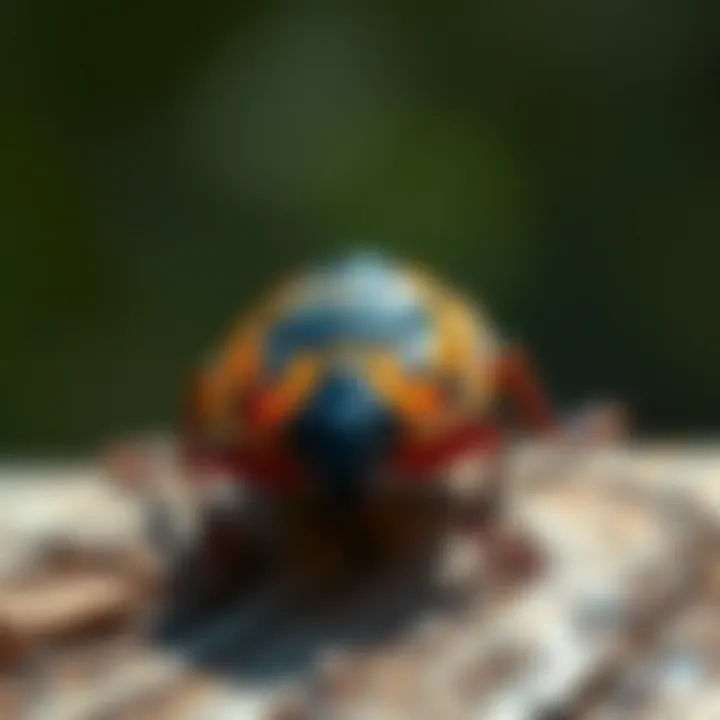
- Marigolds: Known for their vibrant hues, marigolds can repel various pests, including stink bugs.
- Basil: Not only a culinary delight, but basil's scent is also a deterrent.
- Lavender: The beautiful blooms and strong fragrance can help ward off pests.
Creating a garden sanctuary with these plants serves dual purposes: enhancing your outdoor space while working as a defense mechanism against pests.
"A well-thought-out garden can be your first line of defense against stink bugs."
Implementing these prevention techniques can substantially reduce the allure of your home to stink bugs. By being proactive, homeowners can maintain a peaceful living environment, ultimately sidestepping the chaos that a pest invasion can cause.
Natural Removal Options
Natural removal options for stink bugs offer an eco-friendly approach to managing these pests, aligning with the growing concerns for environmental sustainability. Finding ways to control stink bugs without resorting to harsh chemicals can not only benefit the immediate surroundings but also contribute to broader ecological health. This section will delve into effective natural strategies that homeowners can employ, highlighting their specific advantages and any important considerations to keep in mind.
Essential Oils and Their Efficacy
Utilizing essential oils has become a popular method for repelling stink bugs. Oils such as peppermint, rosemary, and lavender are known for their strong scents, which stink bugs find unpleasant. Here’s how they work:
- Repellent Characteristics: The strong fragrances of these oils mask the natural odors that attract stink bugs, effectively steering them away.
- Application Methods: One can mix essential oils with water in a spray bottle and apply directly to areas where stink bugs are commonly found. Frequent reapplication may be necessary, particularly after rain.
Important Consideration: As with any natural remedy, it’s crucial to test the essential oils on a small area to ensure no adverse reaction on surfaces or plants before using them extensively.
Homemade Traps
Homemade traps can provide a straightforward and cost-effective means of reducing stink bug populations. Creating traps using items readily available at home can be surprisingly effective. Here are some options:
- Soap and Water Trap: A bucket filled with soapy water can attract and trap stink bugs. The soapy water disrupts their ability to escape once they contact the surface.
- Light Trap: Using a lamp positioned over a shallow pan of soapy water will lure stink bugs in. They are attracted to the light, dive in, and get trapped.
- DIY Pheromone Traps: A bit more complex but possible, these traps can utilize attractants mimicking the scent released by female stink bugs.
"Crafting homemade traps can often yield surprising results, allowing you to engage directly in pest control while using items that might otherwise go to waste."
Encouraging Natural Predators
Integrating natural predators into your pest control strategy presents a multifaceted approach to managing stink bugs effectively. By fostering a habitat conducive to these predators, homeowners can significantly reduce stink bug populations over time. Consider the following:
- Predatory Insects: Certain beetles and wasps are known to prey on stink bugs. Creating an inviting environment for these insects can help keep stink bug numbers in check. Planting diverse flora can attract beneficial insects that will naturally manage the pest population.
- Bird Habitats: Many birds feed on insects, including stink bugs. Installing birdhouses or providing bird feeders can draw these natural predators to your garden.
- Pollinator Support: Encouraging bees and butterflies through native plants not only supports these crucial pollinators but can also create a balanced ecosystem that deters pests like stink bugs.
While these strategies may take time to cultivate a noticeable reduction in stink bug populations, they promote an ecological approach that respects the environment while addressing pest issues. By opting for natural removal options, homeowners can take significant steps towards managing stink bugs while minimizing their ecological impact.
Chemical Solutions for Stink Bug Control
In the realm of pest management, chemical solutions offer a formidable line of defense against stink bugs. While natural techniques often serve as a first response, the use of targeted chemical treatments can be vital in situations where infestations spiral out of control. Understanding when and how to employ these methods is crucial for homeowners hoping to reclaim their space from these pesky intruders.
Overview of Chemical Treatments
Chemical treatments encompass a range of products designed to eliminate pests effectively. When addressing stink bugs, many homeowners opt for insecticides that are specifically formulated for effective bug control. These treatments not only act quickly but often have residual effects, meaning they continue to kill pests that come into contact with treated surfaces long after application.
Here are some primary types of chemical treatments:
- Insecticides: Often the go-to solution, they quickly target adult stink bugs and their nymphs.
- Miticides: While primarily for mites, certain formulations can impact the broader pest population.
- Granular Products: Used mainly for outdoor applications, effective against stink bugs lurking in garden beds.
For best results, consider treatments that are registered and approved for stink bugs specifically. Checking labels for efficacy against brown marmorated stink bugs—one of the most notorious species—is particularly important.
Targeted Insecticides
Targeted insecticides serve as a powerful weapon in the stink bug extermination arsenal. Often available in various formulations such as sprays and aerosols, these products aim specifically at the insects' nervous systems or metabolic processes, ensuring effective knockdown.
Some widely recognized products include:
- Bifenthrin: Well-known for its fast-acting properties, it interrupts the insect’s nervous system through contact or ingestion.
- Lambda-Cyhalothrin: Popular among homeowners, this option is effective against a broad spectrum of pests, including stink bugs.
- Dinotefuran: This neonicotinoid works uniquely by targeting the nervous systems of the insects effectively.
When applying these insecticides, it’s vital to follow the manufacturer's instructions closely. Apply during cooler times of the day, ideally when bugs are less active, to maximize effectiveness.
Considerations for Chemical Use
While chemical treatments can provide immediate relief, there are important factors to keep in mind. First and foremost, consider the potential impact on non-target organisms, including beneficial insects and pets. Eco-friendliness is critically important for most homeowners. Striking a balance between effective pest control and environmental health often dictates the choice of product.
Here are key aspects to ponder:
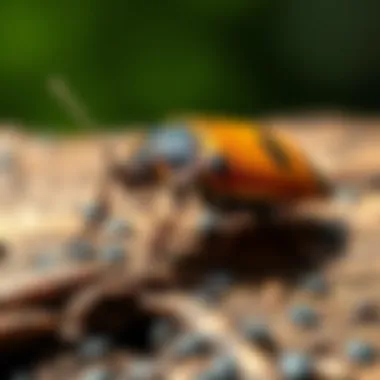
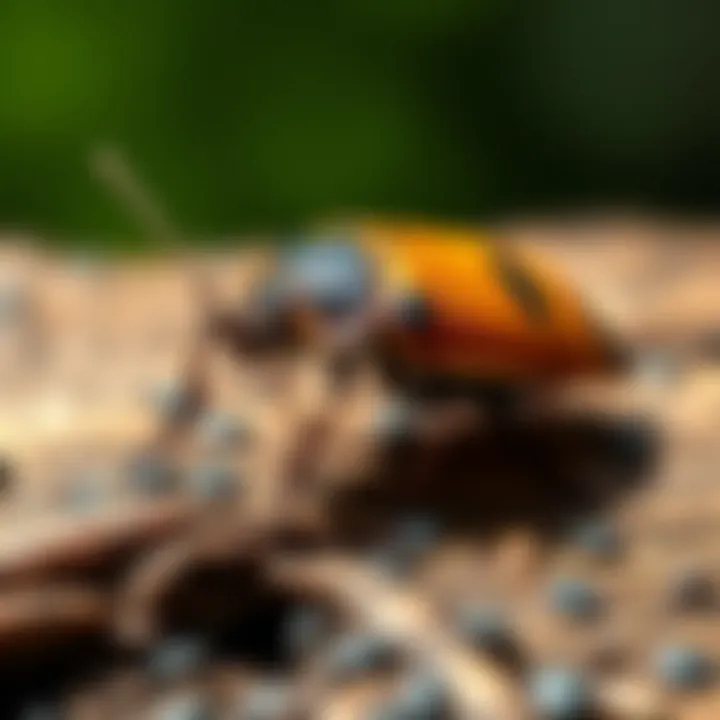
- Application Timing: Pests can be more active during certain times; applying treatments at peak times may yield better results.
- Indoor vs. Outdoor Use: Some chemicals are formulated for specific environments. Using outdoor-only products indoors can lead to ineffective results or even safety hazards.
- Residue Management: Residual chemicals may linger after application. Understanding how long treatments stay effective will influence cleaning routines afterward.
"Chemical treatments can be a double-edged sword, effective yet potentially harmful to the ecosystem if not handled with care."
It’s often beneficial to have a consultation with professional pest control services if unsure about the best approach. They can provide insights tailored to individual circumstances, ensuring a safe and effective battle against stink bugs.
Integrating Pest Control Methods
In tackling the pesky nuisance known as stink bugs, adopting an integrated pest management (IPM) approach is crucial. This strategy combines various methods that can effectively work in tandem to combat infestations. The priority is not simply to eradicate these bugs but to create a balanced ecosystem that minimizes their return. By layering different techniques, homeowners can enhance their overall pest control efforts while considering environmental implications.
Here are a few elements that underscore the benefits of integrating pest control methods:
- Versatility and Adaptability: Stink bug behavior can fluctuate depending on environmental conditions. An integrated approach allows for adjustments that fit specific situations, ensuring responses remain effective as conditions change.
- Minimized Resistance: Using a single method repeatedly can lead to increased resistance. By mixing it up between natural remedies, physical barriers, and chemical treatments, it becomes harder for stink bugs to adapt or develop resilience.
- Environmental Considerations: Homeowners nowadays are growing more conscious of the ecological footprint of their pest control strategies. Combining methods often balances effectiveness with ecological safety, supporting a healthier surrounding environment.
Combining Techniques for Maximum Efficacy
When creating a robust pest control plan, it’s essential to cast a wide net using various methods:
- Physical Barriers: Start by securing your home. Use screens on windows, seal cracks, and close gaps around doors to keep stink bugs at bay.
- Natural Deterrents: Introduce plants that repel stink bugs. Highly aromatic herbs, like basil and garlic, can serve as deterrents, creating a barrier they dislike. Furthermore, you might explore using substances like soapy water as a simple and natural repellent.
- Chemical Treatments: When the infestation overshoots, employing insecticides can be necessary. However, target these treatments to specific areas and avoid widespread spraying to minimize impacts on beneficial insects and the environment.
- Traps: Homemade traps can work well alongside other methods. Using a mixture of water and dish soap in a container, they can attract and catch stink bugs effectively.
"The best defense is a good offense." To ensure longevity in pest control, it’s wise to not only react to infestations as they arise but to stay one step ahead.
Monitoring and Adjusting Strategies
Implementing a successful pest management strategy goes beyond initial action. Continuous monitoring is vital in recognizing when adjustments are needed:
- Regular Inspections: Routinely check for signs of stink bug activity. Look for clustering behavior in your home and monitor any areas susceptible to reinfestation. Regular observation informs whether your current strategies are working or if tweaks are necessary.
- Evaluate Effectiveness: Assess the success of various approaches. Are physical barriers holding up? Are plants still thriving and deterring pests? Keep a journal to track what methods yield the best results.
- Adapt Techniques as Needed: The changing behavior of stink bugs through seasons affects their activity. In winter, they seek warmth; hence, sealing off potential entry points should be prioritized. During summer, it could be beneficial to focus on natural deterrents that work best at hotter temperatures.
- Engage the Community: Sometimes, reaching out to neighbors or community groups can bring insights into effective localized strategies. Joining forums, like those on reddit.com, can provide up-to-date advice from others facing similar challenges.
In summary, integrating pest control methods is not merely a matter of defense. It’s about realistically assessing situations, modifying techniques, and spotting trends based on pest behavior. This holistic process underscores effective management, allowing homeowners not just to fight stink bugs but to cultivate a healthier living environment.
Environmental Considerations
When dealing with stink bugs, it is crucial to consider the environmental implications of various control methods. Effective pest management cannot be achieved in a vacuum; understanding how treatments impact the surrounding ecosystem is vital not just for the immediate problem, but for long-term sustainability. The choices made today regarding stink bug control will ripple through the environment, influencing other species and the ecological balance.
Impact of Treatments on Ecosystems
Every action has a reaction, and using treatments for stink bugs is no exception. While tackling an infestation may seem straightforward, the broader ecological consequences can be significant. Chemical insecticides, for example, are effective at eradicating stink bugs but can also harm beneficial insects and other wildlife. These treatments might disrupt local biodiversity, leading to increased pest problems in the future or the loss of natural predators.
- Non-Target Species: Chemical applications do not discriminate; they can eliminate good bugs like lady beetles, which help control other pests.
- Soil Health: Pesticides that seep into the soil may decrease microbial diversity, affecting plant growth and health.
- Water Quality: Runoff from treated areas can contaminate local waterways, impacting aquatic ecosystems.
Using chemical treatments indiscriminately can create new problems rather than resolving existing ones.
Understanding these impacts encourages a holistic approach. It becomes clear that integrating strategies—where natural solutions complement chemical ones—can minimize risk, paving the way for a healthier environment.
Choosing Eco-Friendly Solutions
Embracing eco-friendly solutions should be at the forefront of any pest management strategy. Applying a combination of natural methods not only aids in managing stink bug populations but also safeguards the ecosystem. By exploring alternative techniques, homeowners can reduce reliance on harmful chemicals while still addressing infestations effectively.
Some viable options include:
- Essential Oils: Certain oils, like peppermint and citrus, can deter stink bugs without posing a risk to beneficial insects.
- Homemade Traps: Using simple traps with household ingredients can catch stink bugs without chemical use. Combine sugar, water, soap, and vinegar in a dish to create a trap that attracts and suffocates these pests.
- Planting Diversity: Introducing plants that attract natural predators can help keep stink bug populations in check. For example, ladybugs and lacewings are often drawn to flowers like dill and yarrow.
Utilizing these eco-friendly methods promotes environmental health while keeping homes and gardens safe from stink bugs. Not only does this strategy benefit one’s immediate surroundings, but it also contributes positively to the well-being of the larger ecosystem.
Incorporating these principles into pest management allows for a thoughtful, impactful approach that aligns with a community-focused mentality. To learn more about the nuances of pest management and environmental protection, websites like EPA or educational resources from local extensions are a great starting point.
Epilogue
The importance of effective stink bug management cannot be overstated. These pests, while small, pose significant challenges to homeowners and gardeners. As discussed throughout this article, a judicious approach to pest control combines both preventive measures and removal strategies. Understanding the biology and behavior of stink bugs lays the groundwork for successful management. When one knows what attracts these bugs, it becomes much easier to thwart an infestation.
Summary of Effective Practices
In summarizing the effective practices to eliminate stink bugs, we focus on several critical components:
- Prevention is Key: Always look for ways to keep stink bugs from entering your home. Replace damaged screens and seal off entry points.
- Natural Solutions: Utilizing natural remedies can often provide a simple and eco-friendly way to handle stink bugs without resorting to chemicals.
- Chemical Treatments: In cases of severe infestations, some homeowners may opt for chemical insecticides. It’s crucial to choose targeted products that minimize environmental impact.
- Monitoring and Adjustments: Pest management is not a one-and-done process. Ongoing monitoring ensures that strategies remain effective, and make adjustments as necessary based on observed results.
- Encouraging Predators: Another effective strategy is fostering a diverse ecosystem that includes natural predators. These predators can help keep stink bug populations in check.
- Perform seasonal inspections to prevent new infestations before they begin.
- Employ deterrent plants such as marigolds or catnip in the garden.
- Essential oils have shown efficacy in repelling these pests. Consider blends of peppermint or lavender oils diluted in water as a spray option.
- Always read labels carefully, adhering to safety guidelines necessary for any application.
Managing these pests involves an integrated approach, utilizing multi-faceted strategies tailored to one’s specific situation. By practicing these techniques, homeowners can protect their homes while being mindful of the environment.















